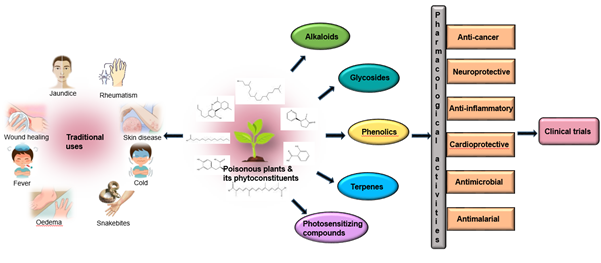“The hidden healers in poisonous plants”, A Research Study by IASST, Guwahati
“The hidden healers in poisonous plants”, A Research Study by IASST, Guwahati
In the corridors of Assam’s lush biodiversity, scientists have unravelled a paradoxical truth– some of nature’s most poisonous plants are also among its most powerful healers. This finding could change the future of medicine.
Plants have been used for their medicinal value since ancient times. While some plants are known for their toxicity, they also contain beneficial phytochemicals important for both plants and humans, indicating their dual nature. Despite being notorious for toxicity, they possess extraordinary compounds that can be converted into powerful weapons for healing when meticulously isolated and altered.
With the advancement of research and development in this domain, the therapeutic potential of phytochemicals derived from toxic plants has surfaced as a promising direction for contemporary medicine, setting the stage for future research and medical progress.
Researchers at the Institute of Advanced Study in Science and Technology (IASST), Guwahati, an autonomous institute of the Department of Science and Technology (DST) tracing the secrets held in the leaves, roots, and sap of the natural world, have comprehensively investigated various poisonous plant species and their phytochemical constituents.

Fig: Graphical representation of the toxic plants & phytochemical constituents
A research team led by Prof. Ashis K. Mukherjee, Director of IASST and Bhagya Lakhmi Rajbongshi, Senior Research Fellow, has reviewed existing literature and identified 70 poisonous plant species which are used traditionally to treat a wide array of illnesses—from fevers and colds to skin diseases and oedema. These plants are already utilized in homeopathy and traditional Indian medicine.
The researchers emphasized that plants produce phytochemicals—natural compounds used for their own survival, which can also affect human biology. While some of these are toxic, others—when isolated and modified—hold immense medicinal promise.
Modern pharmacology is beginning to recognize the potential of these phytochemicals. These toxic compounds can be transformed into potent therapeutic agents with careful scientific processing. The study, published in Toxicon: X (Elsevier), explores how these natural toxins can be studied, validated, and potentially turned into life-saving drugs.
The findings draw upon ethnopharmacology—how indigenous cultures use plants for healing. From treating snakebites to managing jaundice, these traditional remedies are now being re-evaluated through the lens of modern science. The implications are vast. With rigorous testing, these plants could help discover novel drugs for diseases still lacking effective treatment.
The researchers have stressed the importance of rigorous scientific validation before clinical use. Toxicity must be carefully studied to ensure safety. The journey from folk remedy to FDA-approved medicine is long, but with studies like this, the first steps are being taken.